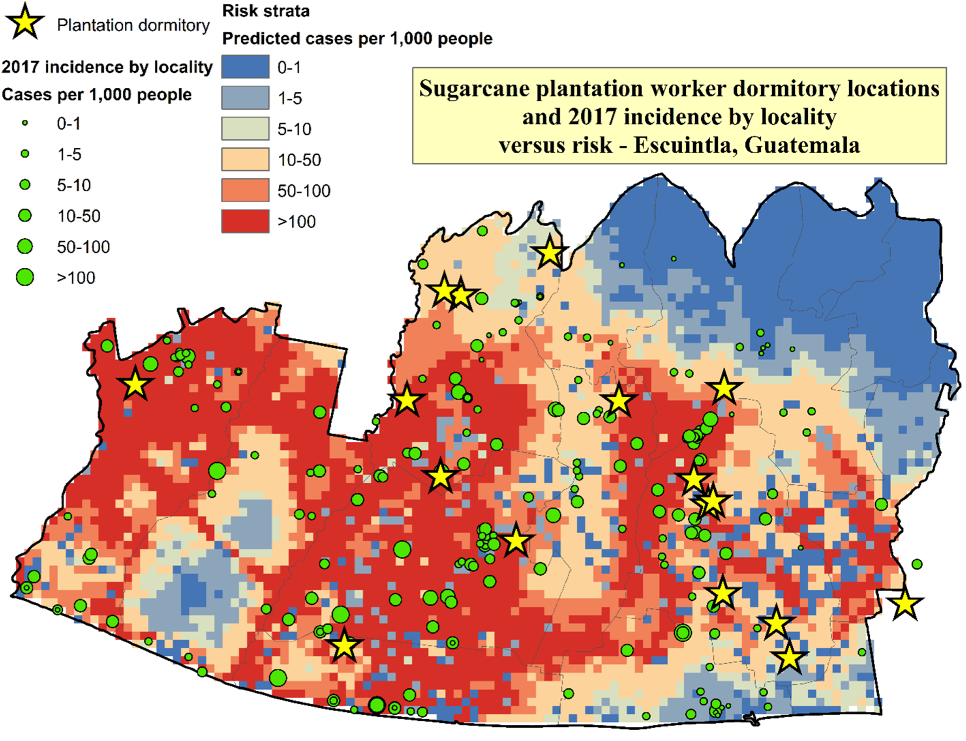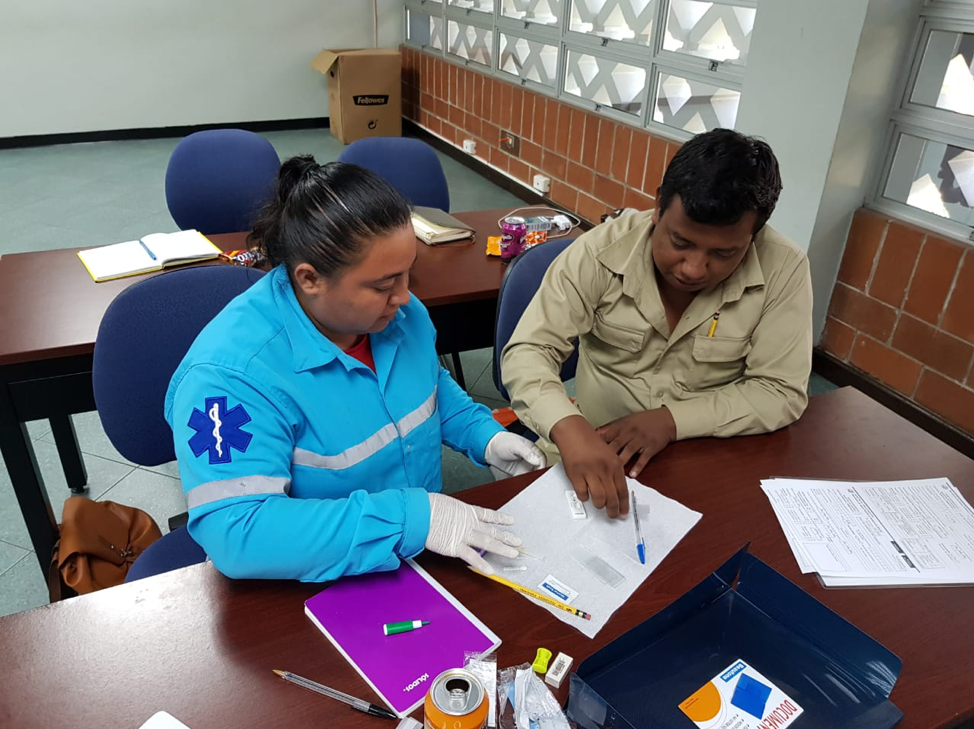A strategic partnership between the government and private industry to improve the health of the local population.
BACKGROUND
In 2018, Guatemala reported 3,084 malaria cases. Half of these cases (1,555) were reported by the department of Escuintla, a region characterized by its large number of sugarcane plantations. These plantations represent the main source of work for numerous local and migrant workers during the sugarcane harvest. Every year, approximately 60,000 workers, from both malaria endemic and non-endemic regions of Guatemala, migrate to Escuintla to harvest sugarcane, according to the Ministry of Health. The harvest, conducted annually from mid-November through mid-May, coincides with peak malaria season, and risk predictions indicate that sugarcane plantations in Escuintla are located in areas most at-risk for malaria transmission.
In Escuintla, sugarcane production is largely managed by 11 companies grouped under the umbrella association, Asociación de Azucareros de Guatemala (ASAZGUA). Because of its commitment to corporate social responsibility and its geographical location in Escuintla, ASAZGUA may be uniquely positioned to be a leader in the path towards malaria elimination in Guatemala. Until 2015, there was very little to no engagement between the National Malaria Program (NMP) in Guatemala and ASAZGUA, limiting the opportunity for cases of malaria to be reported through the official health information system.
While relatively few cases of malaria had been reported among ASAZGUA´s employees prior to the initiation of a partnership with CHAI and the NMP, communities neighboring the sugar plantations experience a heavy burden of infection. In addition, predictive modelling methods suggest that many sugarcane plantation dormitories are located in high-risk areas, with predicted incidence rates of more than 35 cases per 1,000 people per year.

Risk map from Malaria Atlas Project at Oxford University, created with data from Guatemala’s National Malaria Program (NMP). Incidence data by locality from NMP. Sugarcane plantation worker dormitory locations provided by ASAZGUA.
According to an assessment carried out by CHAI and the NMP during 2018, self-medication with suboptimal doses of injectable chloroquine, which can easily be purchased at pharmacies and informal drug shops across Escuintla, is very common among agricultural workers. This practice can lead to cases not being reported in a timely manner, leaving patients to remain sick and capable of perpetuating the transmission of malaria.
It is possible that Migrant workers do not always have access to diagnosis and treatment for malaria since this service is usually only available at the plantations´ central clinics. While there are community volunteers offering free malaria services locally, they are not usually available after working hours.
APPROACH
In 2015, as part of CHAI´s strategy to involve the corporate sector of Escuintla in malaria elimination efforts, CHAI invited ASAZGUA to take part in conversations around the National Strategic Plan 2015-2020 that the NMP was developing at the time with support from CHAI. Since then, CHAI and ASAZGUA have built a strong relationship which has translated into a series of efforts aimed at preventing and controlling Malaria and improving knowledge about risk factors in their areas of influence. All of these efforts have been coordinated through the NMP, with CHAI acting as intermediary between the NMP and ASAZGUA.
This relationship has been founded in several shared goals between CHAI and ASAZGUA: Improving access to health services for people in Escuintla and the promotion of a healthy lifestyle; improving access to Malaria Diagnosis and Treatment among agricultural workers; and pushing Guatemala closer to malaria elimination.
IMPACT
To address limited access to diagnosis and treatment among working age men in Escuintla, the NMP, with the support of CHAI, started by opening 12 new points of care (POCs) in one of the sugarcane plantations of Escuintla, La Unión. These newly-opened POCs operate in addition to the central clinic and several mobile clinics available near worker dormitories. The new POCs are equipped with all the necessary malaria commodities, including rapid diagnostic tests, previously only available in the central clinic, which allows them to receive a test result within 20 minutes and immediately administer treatment if necessary. The installation of the POCs also involved the training of 12 plantation nurses in malaria transmission, diagnosis, treatment and reporting.
In the two months following the training, 21 malaria cases had been reported from the La Unión plantation into the national surveillance system. The fact that the majority of these cases were detected from a single dormitory, Tehuantepec, led to an NMP-initiated active case detection campaign in March 2018, whereby all Tehuantepec residents and plantation staff associated with the dormitory were tested for malaria. Through this active case detection, 13 more cases on the plantation were detected and treated. From January to April 2018, a total of 49 cases were detected in the plantation, most of them from the 789 migrant workers residing there during that period.
The successful case management strategy implemented in La Unión shows the importance of having a strong passive surveillance network serving agricultural workers in the high endemic areas of Escuintla. These successes drew the attention of the ASAZGUA board of directors, which resulted in an agreement with CHAI and the NMP to open new POCs inside other plantations. As a result, ASAZGUA, CHAI and the NMP trained 57 health staff from an additional 5 sugar plantations, installed 13 more POCs across these to expand the network to all its clinics and dorms, and provided the necessary commodities for diagnosis and treatment, training materials, reporting forms, and plastic boxes for malaria medicines.
Uptake of the passive surveillance system in high-risk areas of Escuintla has been further strengthened by including these sugar plantations as beneficiaries of a malaria communication campaign led by the NMP aimed at (i) preventing self-medication, (ii) promoting early diagnosis and treatment-seeking behavior, and (iii) direct observation of treatment for each patient. The campaign took place between February and April 2019 and used video and radio messages that were disseminated among workers and general population via talks by the plantations´ health services, the main local TV network and 4 local radio stations.
MOVING FORWARD
As a result of these interventions, during the 2018-2019 harvest season, 309 diagnostic tests were conducted and 40 cases were diagnosed on the 6 plantations participating in the partnership.

A health worker performs a rapid diagnostic test for malaria.
The plantations that participated had a combined total of approximately 25,000 migrant workers during this harvest season; therefore, only 1.2% of total migrant workers were tested, much lower than the World Health Organization recommendation that in pre-elimination settings at least 10% of a given population at-risk should receive a malaria test each year. This indicator shows that even though these case management interventions have yielded important results, the strategy still needs to be perfected as there is more work to be done on the demand side to ensure that available services are being utilized.
A renewed malaria communication campaign specifically aimed at reaching agricultural workers will be implemented during the fourth trimester of 2019 with the ultimate goal of increasing the uptake of malaria testing within the passive surveillance system by informing workers about: malaria symptoms, problems caused by self-medication with suboptimal doses of chloroquine, and the health services available to them.
The partnership between the NMP and the agricultural corporate sector is critical for malaria elimination in Guatemala. Thus, this year CHAI aims to solidify the relationship by bringing ASAZGUA on as a formal partner in the country’s elimination campaign for long-term support, as well as engaging with other agribusiness plantations in Escuintla outside of the sugarcane industry.
Written by Javier López Sevilla, Escuintla Associate, and Melissa Wiles, Research Associate, Guatemala







